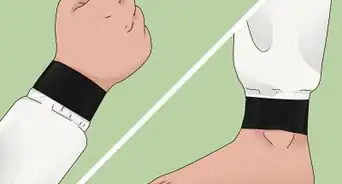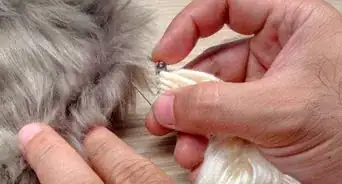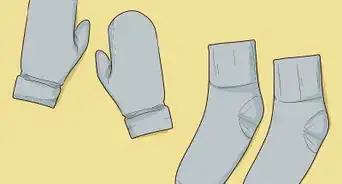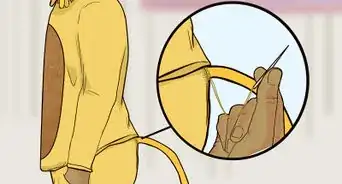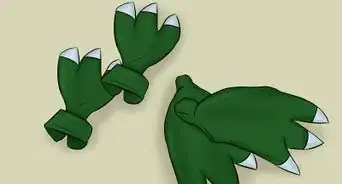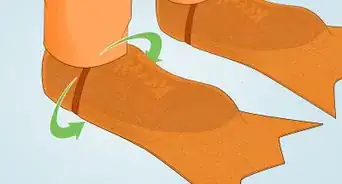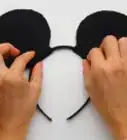This article was co-authored by wikiHow Staff. Our trained team of editors and researchers validate articles for accuracy and comprehensiveness. wikiHow's Content Management Team carefully monitors the work from our editorial staff to ensure that each article is backed by trusted research and meets our high quality standards.
There are 13 references cited in this article, which can be found at the bottom of the page.
The wikiHow Video Team also followed the article's instructions and verified that they work.
This article has been viewed 69,611 times.
Learn more...
Wolves are a popular costume, and one of the most important aspects of a good wolf costume is a good set of ears. You can't just use any set of pointy, furry ears, or you may end up looking like a cat or fox! With the right technique, however, you can create a neat pair of wolf ears to complete any wolf costume.
Steps
Cutting the Fur
-
1Look up reference pictures of the type of ears you want to make. Regardless of whether you are making realistic wolf ears or cartoon wolf ears, you need to have some reference pictures. Decide what sort of wolf you want to be, such as gray or arctic, then look up pictures of that wolf.
- Use real-life pictures if you want to make realistic ears. Use cartoon pictures if you want to make cartoon ears.
-
2Draw 2 right triangles on cardstock, then cut them out for the ear templates. Draw 1 right triangle on a sheet of cardstock; make it about the size of your hand, or whatever size you want your ears to be. Cut it out with scissors, then use it to trace a second right triangle. Cut the second right triangle out too.
- A right triangle has 1 horizontal bottom edge, 1 vertical side edge, and 1 diagonal side edge.
- The diagonal edges will be the outside edges of the ears. The vertical edges will be the inside edges of the ears.
- Don't make the corners too sharp and pointy. Make them slightly rounded for a softer, more natural appearance.
Advertisement -
3Trace the templates onto your desired fur, with the fur running upward. Set a piece of fur fabric furry-side-down on a flat surface, then place the templates on top. Make sure that the fur is running towards the pointed tips of the triangles, then trace around the templates with a chalk or pen.[1]
- Use a pen for light fabrics and chalk for dark.
- Be careful of how you set the templates down. You want a left ear and a right ear.
- Your wolf ears can be any color you want. Gray will look the most real, though.
- Faux fur runs in 1 direction only. Most patterns require the fur to run from top to bottom, but for this, you need it to run from bottom to top.
-
4Trace the templates onto white fur. Flip a piece of white fur over so that the furry side is facing down. Rotate the fabric so that the fur is pointing upwards. Set the templates down, and trace around them with a pen.[2]
- You are making these triangles in addition to the ones that you have already made. In total, you should have 4 triangles, 2 of each color.
- These triangles will be for the inside of your wolf ears. White is the most common, but you can use a different color too.
- If you want to use a different color, consider a lighter shade than the outside of the ears. For example, if your ears are gray, you could do light gray for the inside.
-
5Cut the triangles out with a box cutter, craft blade, or utility knife. Keep the fur furry-side-down. Run a shape box cuter, craft blade, or utility knife across the fabric backing, using the lines you traced as a guide. Be careful to only cut through the fabric and not the actual fur.
- You can use scissors too, but you will have to slide the lower blade through the fur.
- Don't cut straight through the fur, or it will end up too short.
Sewing the Ears
-
1Shave the gray fur with trimmers for a more realistic look. Wolves have furry ears, but the fur is short. If you used fur that is more than 1⁄2 inch (1.3 cm) long, you should trim it. Get out a pair of trimmers, and add a 1⁄4 or 1⁄2 in (0.64 or 1.27 cm) guard. Shave the fur using upward strokes, working from the bottom of the triangle to the top.[3]
- Don't shave all of the fur off! You want it to be about 1⁄4 to 1⁄2 inch (0.64 to 1.27 cm) long.
- You don't have to do this step at all, but it will make a huge difference!
- Comb the ears afterwards with a pet brush or a pet comb to remove any excess fuzz.
-
2Shave the white fur for a more realistic look, if desired. You can leave the white fur long and fluffy, or you can shave just the outer portions of the ear. For example, you can shave most of the fur off, but leave the fur longer along the vertical edge.[4]
- Use the same trimmer and set of guards as you did for the gray fur. You can leave the fur a little longer here too.
- Remember to comb the fur afterwards to remove any fluff.
-
3Pin the white fur to the gray fur with the furry sides facing in. Set the gray fur pieces on a flat surface with the furry side facing up. Place the matching white fur pieces on top, with the furry side facing down. Pin the pieces together along the vertical and diagonal edges; leave the bottom horizontal edge unpinned.
- Don't let any fur stick out from under the fabric when you pin it together. Brush the fur towards the middle of the ears.
-
4Sew the edges of the ears together, but leave the bottom edge open. There are lots of ways that you can do this. You can do it by hand using a whipstitch, or you can do it on a sewing machine. If you choose to use a sewing machine, use a 1⁄4 to 1⁄2 in (0.64 to 1.27 cm) seam allowance and a straight stitch. You can also sew along the edges with a zigzag stitch instead.[5]
- The thread color does not really matter, but it would be best if it matches the white or gray fur.
- If you are using a sewing machine, backstitch when you start and finish sewing.
-
5Turn the ears right-side-out. Turn the ears right-side-out through the gap in the bottom edge. If you need to, use something blunt and pointy, like a knitting needle, to push the top of the triangle out.
- Don't press the ears flat with an iron. The heat may melt the fibers!
-
6Loosen any fur caught in the seams, if needed. Sometimes, long fur gets caught in the stitching when you sew it. To loosen it, find a skinny knitting needle or skewer, and run it along the seams. Use the point to pull any loops of fur caught in the stitching.
- You can also shave the edges of the ears to make them more even. Use your trimmers with a 1⁄4 to 1⁄2 in (0.64 to 1.27 cm) guard.
Adding the Foam and Wire
-
1Trace the cardstock templates onto craft foam, then cut them out. Place the right triangle templates onto a sheet of craft foam. Trace around them with a marker, then put them away. Cut the traced triangles out of the craft foam with scissors.[6]
- You will be putting these inside your wolf ears, so the color does not matter. White will work the best, though, so that it doesn't show through the white fur.
- If you sewed your ears on the sewing machine, you might want to make these a little smaller to allow for the 1⁄4 to 1⁄2 in (0.64 to 1.27 cm) seam allowances.
- Make the triangles the same size as the ears. It is easier to trim them smaller later on. If you cut them smaller now, you may accidentally make them too small.
-
2Hot glue thin wire to the bottom edge of each foam piece. Get some 16- to 18-guage floral wire, then cut it to the same length as the bottom, horizontal edge of each craft foam piece. Hot glue the wires to the craft foam, about 1⁄2 inch (1.3 cm) from the bottom edge.[7]
- You can use thinner wire if you want, but it is too thin, it may not hold its shape well due to the weight of the ears.
- Use wire cutters to cut the wire. Don't use scissors.
-
3Hot glue the foam pieces into each ear. Take 1 of the foam pieces, and turn it so that the wire is facing you. Coat the front with hot glue, then slide it into the matching ear. Gently press down on the fur to seal it against the glue, then repeat the process for the other ear.[8]
- It would be best if the wire is on the same side as the white fur, but it's okay if it isn't.
- Depending on your seam allowances, you may have some foam sticking out of the bottom of each ear. This is okay; you'll trim it off later.
-
4Flip the ears over, and hot glue the back of the foam to each ear. Flip the ears over, then slide your fingers into the pocket created by the foam and the fur. Slide your hot glue gun into the ear and draw a squiggle of hot glue along the foam. Slide the hot glue gun out, then press the fur down.
- Repeat this step for the other ear.
- Leave the bottom edge un-glued. This will make it easier to attach the ears later on.
-
5Trim the bottom edge to make it neater. Chances are, there is some foam sticking out from under your furry ears. Cut across the bottom edge of your ears to get rid of any excess foam. Make it as neat and smooth as you can.[9]
Finishing the Ears
-
1Sew the bottom edges shut by hand with whipstitch. Take your first ear, and sew 1 inch (2.5 cm) along the bottom edge, starting at the left corner. Knot and cut the thread, then sew another 1 inch (2.5 cm) along the bottom edge, this time starting at the right corner. Knot and cut the thread.[10]
- Do this step for the second ear too.
- You need to leave gaps in the middle so that you can insert the headband into them.
- If you wish to secure the ears to hair clips, sew along the entire bottom edge, from left corner to right corner.
-
2Bend the bottom corners of the ears into shape. Thanks to the wire you added, your ears are flexible. Take the corner of your left ear that's on the same side as the vertical edge, and bend it slightly towards the middle of the ear. Repeat the process with the other ear.[11]
- You can bend the corners connected to the diagonal edge too, if you want to.
-
3Position the ears over a thin, metal headband. Take your left ear and place it on the left side off a thin, metal headband. Position the ear how you want it, then pull the ear down until the gap covers the headband. Pin the gray and white fur together under the headband with a sewing pin.[12]
- Repeat this step for the other ear too.
- The gap allows you to pull the gray and white fur around the sides of the headband.
- If you are using hair clips, simply sew a hair clip to the bottom edge of each ear.
-
4Hot glue the gaps shut once you are happy with the positioning. Slide the ears around on the headband until you like how they look. Working 1 ear at a time, remove the sewing pin, then hot glue the gap shut around the headband.
- Skip this step if you sewed the ears to hair clips.
-
5Add details with an air brush, if desired. You don't have to do this, but it can give your ears more depth and make them look more life-like. Choose a paint that's a few shades darker than your gray fur, then air brush it onto the edges of the ears. Extend the color down the tip of the ear and onto the back.[13]
- Add some light gray paint to the inside if each ear. Make it go down to the middle, just to the side of the longer fur.
- Let the paint dry, then comb the fur out with a pet brush or pet comb. This will help break up any chunks of paint.
Community Q&A
-
QuestionCan I use normal headbands instead of metal wire?
 ShibeWolfDIYCommunity AnswerYes, just use one that doesn't have any designs on it, as that will improve the look. For example, I made cat ears using a tan-colored headband, and nobody can see a thing! It looks as if I just have ears.
ShibeWolfDIYCommunity AnswerYes, just use one that doesn't have any designs on it, as that will improve the look. For example, I made cat ears using a tan-colored headband, and nobody can see a thing! It looks as if I just have ears. -
QuestionHow do I make a wolf tail?
 Community AnswerTry making it out of many strands of dark (gray, black, brown, etc.) wool. Tie these together at one end and add a paperclip for attachment to your belt or clothes. Making one from papier mâche might also work, or stuffing a stocking with newspaper.
Community AnswerTry making it out of many strands of dark (gray, black, brown, etc.) wool. Tie these together at one end and add a paperclip for attachment to your belt or clothes. Making one from papier mâche might also work, or stuffing a stocking with newspaper. -
QuestionCan I use anything other than a headband? Like a hair clip?
 Community AnswerYes! Those binder claw hair clips can work pretty well to attach ears to the hair, but be warned that it can be extremely difficult to get the ears to stay on the clips without a lot of work.
Community AnswerYes! Those binder claw hair clips can work pretty well to attach ears to the hair, but be warned that it can be extremely difficult to get the ears to stay on the clips without a lot of work.
Things You'll Need
- Medium to long gray faux fur
- Long white faux fur
- Craft foam
- Thread
- Needle
- Pet brush, pet comb, or fine-toothed comb
- Sewing machine (optional)
- Box cutter, craft blade, or utility knife
- Scissors
- 16- to 18-gauge floral wire
- Wire cutters
- Hot glue
- Thin, metal headband or hair clips
- Air brush (optional)
- Acrylic paint (optional)
References
- ↑ https://www.youtube.com/watch?v=gYN3iBuip7U
- ↑ https://www.youtube.com/watch?v=gYN3iBuip7U&feature=youtu.be&t=30s
- ↑ https://www.youtube.com/watch?v=gYN3iBuip7U&feature=youtu.be&t=50s
- ↑ https://www.youtube.com/watch?v=gYN3iBuip7U&feature=youtu.be&t=1m10s
- ↑ https://www.youtube.com/watch?v=gYN3iBuip7U&feature=youtu.be&t=2m55s
- ↑ https://www.youtube.com/watch?v=gYN3iBuip7U&feature=youtu.be&t=2m4s
- ↑ https://www.youtube.com/watch?v=gYN3iBuip7U&feature=youtu.be&t=2m20s
- ↑ https://www.youtube.com/watch?v=gYN3iBuip7U&feature=youtu.be&t=4m
- ↑ https://www.youtube.com/watch?v=gYN3iBuip7U&feature=youtu.be&t=5m
About This Article
You can make your own wolf ears for dressing up right at home. All you’ll need is dark faux fur, white faux fur, craft foam, cardstock, a headband, a hot glue gun, a sewing kit, and wire. To get started, you'll need to cut out 2 triangles of dark fur and 2 triangles of white fur and sew the white triangles to the dark triangles. Leave one of the edges open so you can slide something into each ear. Then, cut 2 triangles out of the craft foam, hot glue some wire around the edges so the ears don't flop over, and slide them into the ears. Finally, sew the ears shut and hot glue them onto your headband. For more tips, including how to make your wolf ears more detailed with an airbrush, read on!




